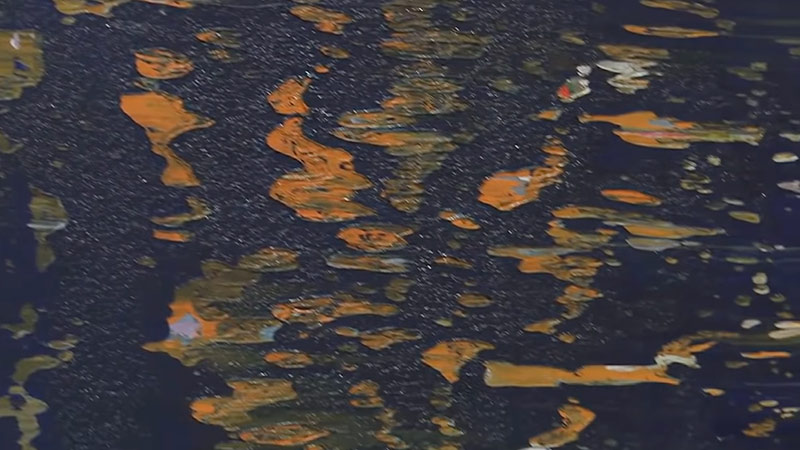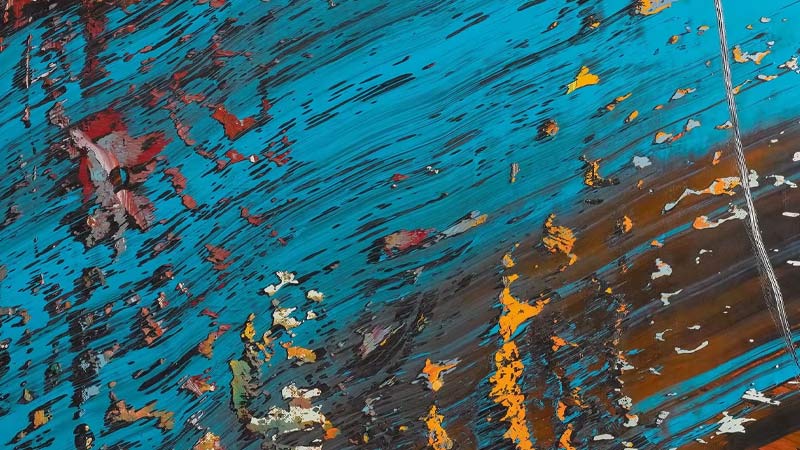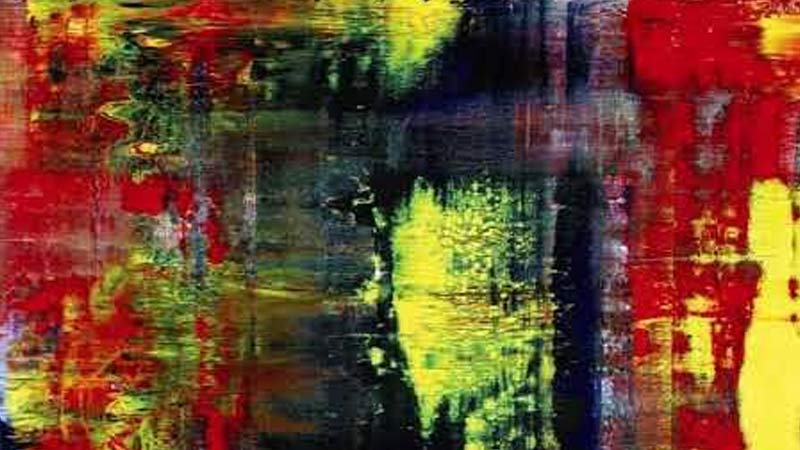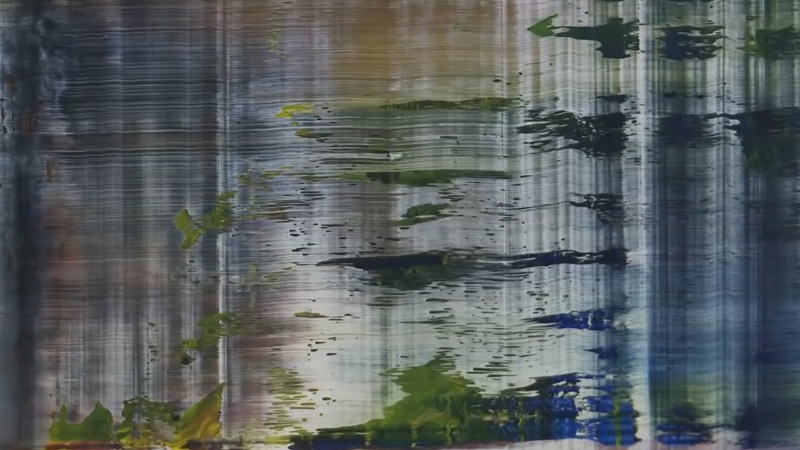In the world of contemporary art, few names evoke as much curiosity and intrigue as Gerhard Richter. Renowned for his enigmatic and thought-provoking creations, Richter’s paintings often leave viewers pondering one burning question: why does he blur his paintings?
This blog post delves deep into the artistic genius of Gerhard Richter and explores the fascinating reasons behind his deliberate choice to blur his artworks.
From his early experiments with abstraction to the philosophical underpinnings of his work, we will uncover the layers of meaning concealed beneath the blurred surfaces of Richter’s canvases.
Join us on this artistic journey as we unravel the mysteries behind Richter’s blurred masterpieces and gain a fresh perspective on his unparalleled contribution to the world of contemporary art.

Who Is Gerhard Richter Richter?
Gerhard Richter is a renowned German visual artist known for his diverse and prolific body of work that spans various styles and techniques.
Born on February 9, 1932, in Dresden, Germany, Richter is considered one of the most significant contemporary artists.
His works often explore the relationships between representation, abstraction, and the nature of visual perception.
Key aspects of Gerhard Richter’s career and art include:
Early Life and Education
Richter grew up in East Germany and initially trained as a socialist muralist before fleeing to West Germany in 1961.
He studied at the Kunstakademie Düsseldorf, where he encountered various artistic movements and styles.
Photorealistic Paintings
In the 1960s, Richter gained recognition for his photorealistic paintings based on black-and-white photographs.
These paintings often depicted mundane and everyday scenes, challenging traditional notions of artistic subject matter.
Blur and Abstraction
Richter later moved away from strict photorealism and began experimenting with abstraction and a blurred style.
His “Blur” or “Squeegee” paintings, created by dragging a squeegee across the canvas, resulted in works that were dynamic, ambiguous, and open to multiple interpretations.
Color Charts
Richter explored color theory in his series of Color Charts, which were grids of color samples.
These works questioned the emotional and aesthetic impact of color, and they reflected his interest in systematic approaches to art.
Atlas
“Atlas” is an ongoing collection of Richter’s visual notations, sketches, and photographs that he has compiled since the 1960s.
It serves as a kind of visual diary and a source of inspiration for his larger works.
Abstract and Concrete Art
Richter has created both abstract and concrete art throughout his career.
His abstract paintings often involve a complex layering of colors and textures, challenging viewers to engage with the work on an emotional and intellectual level.
Large-Scale Works
Richter has produced large-scale works, including his famous “Cage” series and “Birkenau” series, which engages with historical and political themes.
These works are characterized by their intense visual impact and thought-provoking content.
Prolific Career and Recognition
Over the decades, Richter has exhibited extensively internationally, and his work is held in major museum collections around the world. He has received numerous awards and honors for his contributions to contemporary art.
Gerhard Richter’s ability to navigate and contribute to various artistic movements, coupled with his continuous experimentation with different styles and techniques, has solidified his place as a pivotal figure in contemporary art.
His work reflects a deep engagement with questions about the nature of representation, the act of seeing, and the possibilities of visual expression.
Gerhard Richter Blur Technique

Gerhard Richter’s blur technique is a distinctive approach to painting that involves intentionally smearing or dragging wet paint across the canvas, often using tools like a squeegee.
This technique results in a blurred and abstract effect, challenging traditional notions of representation.
Here are key aspects of Gerhard Richter’s blur technique:
Tools and Materials
Richter commonly employs a squeegee, a rubber or silicone tool with a flat, smooth edge, to create the blurred effect.
He uses high-quality artist’s paints, allowing for a rich and varied color palette. The use of oil-based or acrylic paints depends on the specific work.
Layering of Paint
Before employing the blur technique, Richter applies multiple layers of paint to the canvas.
These layers can be of different colors or tones, creating a complex and textured base. The layering contributes to the depth and richness of the final composition.
Drag and Smear Motion
The key action in the blur technique involves dragging or smearing the squeegee across the wet paint.
Richter may move the tool horizontally or vertically, varying the direction to achieve different effects. The pressure applied, along with the viscosity of the paint, influences the resulting patterns.
Abstraction and Ambiguity
The blur technique introduces an element of abstraction, as recognizable forms and details are intentionally obscured.
Richter embraces ambiguity, allowing viewers to engage with the paintings on a more subjective and interpretative level. The images often hover between representation and abstraction.
Texture and Surface Variation
The dragging motion of the squeegee creates a varied texture on the canvas. Some areas may be thinly covered, allowing underlying layers to show through, while others may have thicker accumulations of paint.
This interplay of textures contributes to the visual interest of the surface.
Dynamic and Spontaneous Process
Richter’s blur technique is a dynamic and spontaneous process that embraces chance.
The way the paint reacts to the movement of the squeegee is not entirely predictable, and Richter values the unexpected outcomes that arise during the creation of each piece.
Multiplicity of Interpretations
The intentional blurring of images opens up the possibility for multiple interpretations. Viewers are encouraged to bring their own experiences and emotions to the artworks.
The blurred effect may evoke a sense of memory, impermanence, or the transient nature of visual perception.
Evolution and Exploration
Richter’s use of the blur technique represents an evolution in his artistic style.
While he initially gained recognition for photorealistic paintings, this experimentation with abstraction and the blur technique allowed him to explore new possibilities and challenge established norms.
Gerhard Richter’s blur technique is a testament to his willingness to push the boundaries of traditional painting and engage with the complexities of visual representation.
The intentional blurring creates paintings that are not only visually captivating but also conceptually rich, inviting viewers to participate actively in the interpretation of the artwork.
Why Does Richter Blur His Paintings?

Gerhard Richter’s decision to blur his paintings is a deliberate artistic choice that stems from his exploration of various concepts, challenges to traditional modes of representation, and a desire to engage viewers on multiple levels.
Here are six reasons why Richter employs a blurred technique in his paintings:
To Remove Focus
One of the primary reasons that Gerhard Richter blurs his paintings is to remove the focus from any one element of the painting. As he once explained, “I blur to make everything equal, everything equally important and equally unimportant.”
This approach allows Richter to create a sense of ambiguity and mystery within his paintings, encouraging viewers to engage more deeply with the work and draw their own interpretations.
By blurring the lines between different parts of the painting, Richter creates a kind of visual “noise” that can obscure specific details and shift the focus away from any one element.
This can be seen in many of Richter’s abstract works, where the blurred shapes and colors seem to flow into one another, creating a sense of motion and fluidity.
Abstraction and Expression
Richter’s use of blur aligns with his broader exploration of abstraction and expression.
The intentional blurring serves as a form of abstraction, allowing the artist to focus on the essential elements of color, form, and composition while distancing the work from a strict representation of reality.
To Explore the Relationship Between Photography and Painting
Gerhard Richter has long been fascinated by the relationship between photography and painting, and this interest has played a significant role in his decision to blur his paintings.
Richter’s early career was characterized by his exploration of photorealism, a style that seeks to replicate the visual effects of photography in painting.
However, as he continued to experiment with different styles and techniques, Richter became increasingly interested in the ways that photography could inspire new approaches to painting.
He saw photography as a way to capture fleeting moments and movements that are difficult to replicate in painting, and he began using blurring as a way to evoke those effects in his work.
Reproduction and Mass Media
Richter’s blurred paintings can be seen as a response to the prevalence of reproduced images in mass media. In a world inundated with images, he questions the role of art and the authenticity of representation.
The blurring effect may mimic the imperfections and distortions introduced in the reproduction process.
Emotional Impact
The act of blurring can evoke a sense of emotion and atmosphere in Richter’s paintings. By obscuring certain details, he directs the viewer’s attention to the overall emotional tone or mood of the artwork. The blurred elements contribute to a dreamlike or introspective quality.
Critical Engagement with Art History
Richter is known for engaging critically with the history of art. His blurred paintings can be seen as a commentary on the traditions of portraiture and landscape painting.
By intentionally blurring figures or scenes, he disrupts conventional expectations and prompts viewers to reconsider established norms in art history.
To Create Distance and Detachment
Another reason that Gerhard Richter blurs his paintings is to create a sense of emotional distance and detachment. By blurring the lines between different parts of the painting and obscuring specific details, Richter encourages viewers to approach the work in a more objective and analytical way.
This approach can be seen as a response to the emotionalism and subjectivity that was prevalent in the art world during Richter’s early career.
In contrast to those artists who sought to convey specific emotions and messages through their work, Richter sought to create paintings that would allow viewers to engage with the work on their own terms, without being influenced by the artist’s own emotional state.
Examples of Richter’s Use of Blurring
Gerhard Richter’s use of blurring is a defining feature of his artistic style, and it can be seen in many of his works across different periods and genres. Here are a few examples of paintings that use blurring as a key element:
“Abstract Painting (809-4)” (1994

This abstract painting features a series of blurred rectangles and squares in muted shades of green and blue. The blurring creates a sense of motion and depth as if the shapes are shifting and dissolving before our eyes.
The effect is both mesmerizing and disorienting, inviting the viewer to engage with the painting on a purely sensory level.
“October 18, 1977” (1988)
This large-scale painting is based on a photograph of the members of the Baader-Meinhof group, a leftist terrorist organization active in Germany in the 1970s.
The photograph has been blurred and distorted so that the figures are barely visible beneath a layer of gray and white smears. This creates a sense of unease and detachment, emphasizing the futility and violence of the group’s actions.
“Betty” (1988)
This portrait of Richter’s daughter Betty is based on a photograph, which Richter has blurred to the point of near-indistinctness. The resulting painting has a dreamlike quality as if Betty’s image is fading in and out of focus.
This blurring creates a sense of intimacy and vulnerability as if we are seeing Betty through the eyes of a parent who is struggling to capture her fleeting essence.
In each of these paintings, the blurring contributes to the overall effect of the work in different ways. In “Abstract Painting (809-4),” the blurring creates a sense of motion and fluidity that invites the viewer to get lost in the painting’s intricate patterns.
In “October 18, 1977,” the blurring creates a sense of detachment and unease that emphasizes the disturbing subject matter.
In “Betty,” the blurring creates a sense of intimacy and vulnerability that invites the viewer to connect with the subject on a deeper level. By using blurring in these different ways, Richter demonstrates the versatility and expressive power of this technique.
Significance of Gerhard Richter Blurred Paintings

Gerhard Richter’s blurred paintings hold significant artistic and conceptual importance, contributing to the evolution of contemporary art and challenging traditional notions of representation.
Here are several aspects that highlight the significance of Gerhard Richter’s blurred paintings:
Challenge to Photorealism
Richter initially gained recognition for his photorealistic paintings that meticulously recreated everyday scenes.
The transition to blurred paintings represented a deliberate departure from strict representation. By intentionally obscuring details, Richter challenged the notion of photographic truth in painting.
Exploration of Abstraction
The blurred paintings mark Richter’s exploration of abstraction. Through the use of the squeegee and the deliberate smearing of paint, he creates works that exist in a state between representation and abstraction.
This shift reflects an openness to experimentation and a departure from more conventional artistic practices.
Emphasis on Process and Materiality
The blurred technique emphasizes the process of creation. The physical act of dragging the squeegee across the canvas introduces an element of spontaneity and unpredictability.
The materiality of the paint, with its varied textures and depths, becomes integral to the visual experience of the artwork.
Multiplicity of Interpretations
The intentional blurring invites viewers to participate actively in the interpretation of the artwork. With recognizable forms obscured, the paintings become open to a multiplicity of meanings.
Viewers are encouraged to bring their own experiences and emotions to the blurred images, fostering a more subjective and personal engagement.
Engagement with Memory and Perception
The blurred paintings engage with the themes of memory and perception. By distorting and blurring images, Richter prompts viewers to consider the fallibility and subjectivity of visual memory.
The paintings evoke a sense of haziness, emphasizing the transient nature of perception.
Critical Engagement with Art History
Richter’s blurred paintings can be seen as a critical engagement with the history of art. By challenging traditional modes of representation, he prompts a reconsideration of established norms.
The deliberate blurring disrupts expectations and encourages a fresh perspective on the role of painting in the context of art history.
Influence on Contemporary Art
Richter’s blurred paintings have had a profound influence on contemporary art. Artists inspired by his work have explored similar techniques that involve abstraction, layering, and a departure from strict representation.
The blurred paintings have become iconic in discussions about the intersection of painting, photography, and abstraction.
Integration of Chance
The blur technique introduces an element of chance into the artistic process. Richter values the unpredictability of outcomes, allowing the materials to interact in ways that are not entirely controlled.
This integration of chance aligns with broader movements in contemporary art that embrace randomness and spontaneity.
Gerhard Richter’s blurred paintings represent a significant shift in his artistic practice and contribute to broader conversations within the art world.
The intentional blurring challenges conventions encourages subjective interpretation, and engages with themes that transcend the visual realm, making these works enduring and influential in the landscape of contemporary art.
Examples of Gerhard Richter’s use of blurring in his paintings
| Painting title | Year | Medium | Description of blurring |
|---|---|---|---|
| “Betty” | 1988 | Oil on canvas | The portrait of Richter’s daughter is partially blurred, creating a dreamlike effect and blurring the line between representation and abstraction. |
| “October 18, 1977” | 1988 | Oil on canvas | The painting depicts the aftermath of the deaths of the Baader-Meinhof group in their prison cells. The blurred images of the newspaper photographs evoke the chaos and confusion surrounding the events. |
| “Abstract Picture” | 1992 | Oil on canvas | The painting consists of layers of translucent colors, creating a blurred effect that suggests movement and depth. The blurring creates a sense of ambiguity and allows the viewer to project their own interpretations onto the painting. |
| “Ema (Nude on a Staircase)” | 1966 | Oil on canvas | The painting depicts Richter’s wife on a staircase, partially blurred to create a sense of motion and evocative of the stop-motion photography of Eadweard Muybridge. The blurring also creates a sense of detachment, distancing the viewer from the subject. |
FAQs
While Richter is perhaps the most well-known artist associated with blurring in painting, he is not the only artist to use this technique.
Many artists throughout history have experimented with blurring, from the Impressionists to the Abstract Expressionists. However, Richter’s use of blurring is distinctive in its versatility and range of applications, making it a defining feature of his artistic style.
Blurring is a particularly effective technique for creating ambiguity and detachment because it obscures specific details and blurs the boundaries between different parts of the painting.
This allows the viewer to engage with the painting on a more abstract and formal level, without being distracted by specific details or emotional cues. Other techniques, such as distortion or fragmentation, can also create ambiguity and detachment, but blurring has a unique ability to create a sense of fluidity and motion.
Richter has acknowledged that his interest in blurring is influenced by his background in photography, as well as his interest in other media such as film and television. His paintings often have a cinematic quality, with blurred images suggesting motion and emotion.
However, Richter’s use of blurring is not limited to replicating photographic effects, but rather is a way of exploring the boundaries and possibilities of painting as a medium.
While Richter’s work has often been interpreted in political or social terms, his use of blurring is not specifically related to any particular agenda or viewpoint.
Rather, Richter’s blurring technique is a formal element of his painting style, which he uses to create a sense of ambiguity and detachment that allows the viewer to engage with the work in a more objective and analytical way.
However, the subjects of Richter’s paintings, which often include historical events and political figures, may have political or social implications that are open to interpretation.
Conclusion
Gerhard Richter’s use of blurring in his paintings serves multiple purposes. It allows him to explore the relationship between photography and painting, create a sense of emotional detachment, and encourage viewers to engage with the formal elements of the painting.
By blurring the lines between different parts of the painting, Richter creates a sense of ambiguity and encourages interpretation, inviting the viewer to participate in the creative process.
His use of blurring also blurs the boundaries between different mediums, allowing photography and painting to inform and inspire each other. Through his use of blurring, Richter demonstrates the versatility and expressive power of this technique, making it a key element of his artistic style.